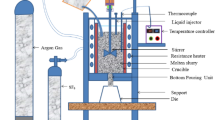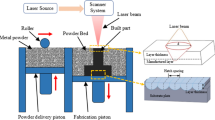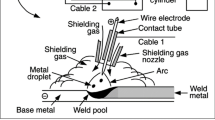Conclusions
The strength of a composite iron-base powder reinforced with disperse inclusions is 3–6 times that of the refractory compound itself. The highest strength is exhibited by composites containing 40–70 vol. % of refractory compound inclusions. When the particle size of a powder with such a composite structure is decreased, its grain strength grows as a result of work hardening of its matrix. A considerable increase in strength is due to the formation of interatomic bonds at phase boundaries.
Similar content being viewed by others
Literature cited
S. Z. Bokshtein (editor), Composite Fiber Materials [Russian translation], Mir, Moscow (1967).
M. G. Bogdanovich et al., “Dependence of the abrasive power of diamond powders on their grain strength,” Sintetich. Almazy, No. 2, 12–13 (1972).
V. N. Bakum et al., Assessment of Synthetic Diamonds by Strength [in Russian], Naukova Dumka, Kiev (1960).
R. B. Kotel'nikov, S. N. Bashlykov, Z. R. Rashakbarov, and A. I. Kashtanov, Extra Refractory Elements and Compounds [in Russian], Metallurgiya, Moscow (1969).
V. A. Batyrev, “A method of investigating the effect of chemical linkage on the fine strucutre of x-ray emission spectra in microvolumes of materials,” Izv. Akad. Nauk SSSR, Ser. Fiz.,31, No. 6, 883 (1967).
A. T. Shuvaev, “Effect of chemical linkage on the x-ray spectra of elements,” Author's Abstract of Candidate's Dissertation, Rostov-on-Don (1963).
S. S. Aleskovskii, Stoichiometry and Synthesis of Hard Compounds [in Russian], Khimiya, Leningrad (1976).
I. A. Vashchukov et al., “Thermodynamic properties of an distribution of electron bands in transition d metal carbides,” Ukr. Fiz. Zh., No. 2, 241 (1978).
G. S. Ansell and V. Lenel, “Criteria for yielding of dispersion-strengthened alloys,” Acta Metall.,8, No. 9, 612–616 (1960).
Author information
Authors and Affiliations
Additional information
Translated from Poroshkovaya Metallurgiya, No. 2(206), pp. 9–12, February, 1980.
Rights and permissions
About this article
Cite this article
Maiboroda, V.P., Karyuk, G.G., Trefilov, V.I. et al. Strength of a composite abrasive powder. Powder Metall Met Ceram 19, 77–79 (1980). https://doi.org/10.1007/BF00792028
Received:
Issue Date:
DOI: https://doi.org/10.1007/BF00792028




